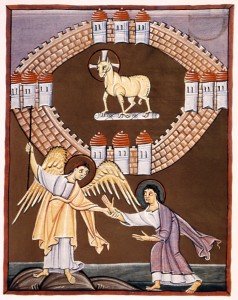 A chronological approach to the book of Revelation sets its composition in the late first-century and asks what it meant (past tense) then. What did its language mean to its author and to the early Christian communities to which it was addressed? Within their shared field of meaning, what did the author communicate to them?
A chronological approach to the book of Revelation sets its composition in the late first-century and asks what it meant (past tense) then. What did its language mean to its author and to the early Christian communities to which it was addressed? Within their shared field of meaning, what did the author communicate to them?
To illustrate this point, let us review a few illuminating and important examples:
The author expected the events he describes to happen in his near future. Seven times (note the number seven again), he writes, “The time is near, ““what must soon take place,” “I am coming soon.” “Soon” and “near” cannot plausibly be extended to two thousand years and counting. Like the authors of a number of New Testament documents, John of Patmos thought the second coming would happen soon.
The author identified the dragon, the ancient serpent, Babylon the Great, the great whore, the beast whose number is 666. It was Rome – not just the city, but the Roman Empire. The identification is unmistakable in a late first-century context. Because of the Roman destruction of Jerusalem in 70, Jews and Christians spoke of Rome as “Babylon,” because the Babylonian Empire was the previous destroyer of the holy city and its temple. The woman and the beast live in a city built on seven hills, a designation for Rome that goes back to antiquity. It is the city that rules the world; in a first-century context, that could only be Rome. The number 666 is a numerical code for Caesar Nero, the first Roman persecutor of Christians. The beast is the Roman Empire of the first century – not some future beast from our point in time.
The author chastised most of the communities to whom Revelation was addressed for their accommodation to the imperial way of life. They had abandoned their first love, forgotten what they received and heard, and become lukewarm.
The author’s message of the imminent destruction of Rome and the second coming of Jesus encouraged his followers to hold fast. The powers who ruled and oppressed that world and rejected the vision of a new world, the kingdom of God proclaimed by Jesus and his followers, would soon be no more. “Be stead, take courage, do not be afraid,” they were told.
John expected the destruction of Rome and the second coming of Jesus to occur soon. Obviously, he was wrong. They didn’t happen.
This realization raises an interpretive question. What is truly a faithful interpretation of Revelation in our time? Is it one that affirms that what it says will still happen? That there will be a future beast who in a final battle at Armageddon will be vanquished by Jesus at the head of an army of heaven? That the plagues and wars and earthquakes and other signs of the end are still going to occur?
Many believe this is yet all to come!
